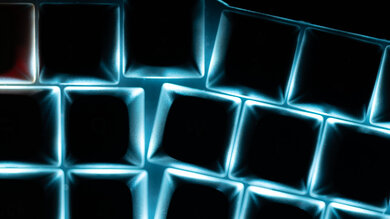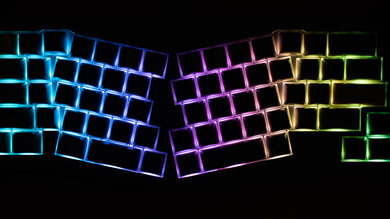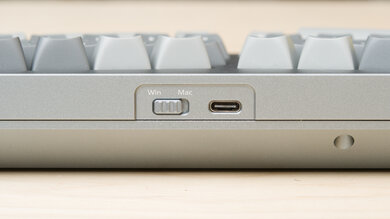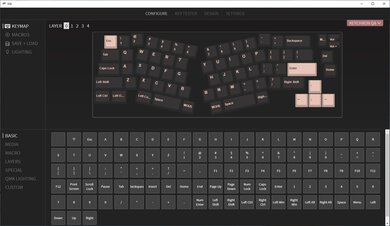The Keychron Q8 is the eighth keyboard in Keychron's Q-series. Like the others in this series, this wired-only unit is designed to be fully customizable, so it has a hot-swappable printed circuit board to easily replace the switches, screw-in stabilizers, and an included toolkit to deconstruct the keyboard. However, what sets this keyboard apart from the several others in the series is the compact (65%) Alice layout, which splits the keys into two angled clusters. As an added detail not usually found on split-key layouts, this keyboard has two "B" keys to more easily adapt to the layout if you're used to straight boards.
Our Verdict
Although not designed for this use, the Keychron Q8 is a great keyboard for gaming. It feels very well-built and has RGB backlighting that's fully customizable using the companion software. You can also use the companion software to program macros to any key and adjust the key mapping. It's also comfortable to use thanks to its Alice layout, but this layout can take some time to get used to. Unfortunately, its latency is too high for competitive or fast-paced games, but it's perfectly suited for casual gaming.
-
Incredible build quality.
-
Easily customizable; hot-swappable PCB.
-
Companion software available on all desktop operating systems.
-
Alice layout takes a bit of getting used to at first.
-
Latency too high for competitive gaming.
The Keychron Q8 isn't recommended for use with mobile devices, though you can technically use this keyboard with any device with a USB-C port. That said, it's made of solid aluminum and is very heavy, so it isn't a very portable option.
The Keychron Q8 is an excellent keyboard for office use. It feels incredibly well-built and comfortable to type on, thanks to its Alice layout. The companion software is available on all major operating systems, and there's an operating system toggle on the top of the keyboard to ensure full compatibility. It's also very quiet to use, thanks to the layers of sound-dampening foam inside the board. However, the Alice layout can take a bit of getting used to at first, so your typing speed and accuracy will take a bit of a hit if you're only used to straight boards.
-
Very comfortable to use.
-
Excellent typing quality.
-
Incredible build quality.
-
Easily customizable; hot-swappable PCB.
-
Companion software available on all desktop operating systems.
-
Alice layout takes a bit of getting used to at first.
The Keychron Q8 is a great keyboard for programming. Its companion software is available on all major desktop operating systems, including Linux, so you can easily program macros to any key regardless of what system you use. It also features a very high build quality, and it's comfortable to type on for long periods, thanks to the Alice layout. Unfortunately, since it's wired-only, you can't use it in a multi-device setup. Though the Alice layout is comfortable, there's a bit of a learning curve, which will impact your typing speed and accuracy at first.
-
Very comfortable to use.
-
Excellent typing quality.
-
Incredible build quality.
-
Easily customizable; hot-swappable PCB.
-
Companion software available on all desktop operating systems.
-
Alice layout takes a bit of getting used to at first.
-
Wired-only.
The Keychron Q8 is a poor keyboard to use with a home theater PC setup since it's a wired-only unit that lacks a trackpad for on-screen navigation. While it does have backlighting, the key legends aren't shine-through, so they may be a bit more difficult to see in the dark unless you're seated directly in front of the keyboard.
-
Incredible build quality.
-
Alice layout takes a bit of getting used to at first.
-
Wired-only.
-
No trackpad for on-screen navigation.
- 8.5 Gaming
- 3.5 Mobile/Tablet
- 8.6 Office
- 8.4 Programming
- 5.6 Entertainment / HTPC
Changelog
- Updated Sep 23, 2022: Review published.
- Updated Sep 20, 2022: Early access published.
- Updated Sep 19, 2022: Our testers have started testing this product.
- Updated Aug 24, 2022: The product has arrived in our lab, and our testers will start evaluating it soon.
- Updated Aug 12, 2022: We've purchased the product and are waiting for it to arrive in our lab.
Differences Between Sizes And Variants
The Keychron Q8 comes in three colorways: Carbon Black, Silver Grey, and Navy Blue. It also comes pre-assembled with your choice of Gateron G Pro tactile Brown, linear Red, or clicky Blue switches. Alternatively, you can get the barebones base of this keyboard with no switches or keycaps. There's also the option to get this keyboard with a knob in the top right corner. We bought and tested the pre-assembled Silver Grey unit with a knob and Gateron G Pro Brown switches installed. While we normally include a photo of the label in our reviews, this unit doesn't have one.
Compared To Other Keyboards
The Keychron Q8 is the eighth keyboard in Keychron's customizable Q-series. The major difference in this board is the Alice layout. While this layout isn't considered a fully ergonomic style since the keys aren't fully split apart, the angled key clusters promote a more natural posture in your wrists and elbows. However, there's a learning curve involved in using this keyboard as it's different from typical straight keyboards. To help make learning the layout easier, this keyboard has two "B" keys, one for each cluster, which is a rare find on a split-key style board, as the "B" key is typically put on one side or the other as it's the most middle key in the alphanumeric cluster. Like the other Keychron Q-series boards, this one is fully customizable and includes a toolkit to help you personalize the board to your liking. As a minor note, the latency on this board is slightly higher than the others, but it's still great for casual gaming.
If you're interested in more options, check out our recommendations for the best ergonomic keyboards, the best keyboards for typing, and the best Keychron keyboards.
The Keychron Q8 is the next release in Keychron's Q-series lineup after the Q7. These boards are incredibly similar in their design and build quality, but the major difference is that the Q8 has an Alice layout, which is a split key layout with two key clusters sitting at an angle, while the Q7 is a typical straight profile board. The Q7 has more navigational cluster buttons, as it's a compact (70%) keyboard.
The Keychron Q8 is a wired-only Alice layout keyboard from Keychron's premium Q-series lineup. Alternatively, the Keychron K8 is a wireless keyboard with a TenKeyLess size from Keychron's more budget-friendly K-series lineup. The Q8 has companion software, which the K8 lacks. The Q8 is better suited for permanent desk setups, while the K8 is more portable and more versatile.
The Keychron K2 (Version 2) is a compact (75%) wireless keyboard that's fairly customizable as you can a variant with a hot-swappable printed circuit board (PCB). The Keychron Q8, on the other hand, is a wired-only, Alice layout keyboard. The Alice layout means the keys are split into two distinct clusters that are angled away from each other to promote a more natural wrist placement. That said, the Q8 takes a bit longer to get used to at first, while you'll have no problem using the K2 V2 right out of the box.
The Logitech ERGO K860 Wireless and the Keychron Q8 are two very different keyboards, though they may look slightly similar. The Logitech has a true ergonomic design with a wave-like curve in the middle that splits the keys into two descending clusters. It also has negative incline settings to keep your wrists from bending upwards. The Keychron has a fixed incline setting that's still fairly high, so you'll have to flex your wrists upwards to reach the keys. While it also has two split key clusters, it lacks the curve in the middle that makes it a truly ergonomic layout, but the angled key clusters help to promote a more natural posture. That said, if ergonomics are the name of the game, the Logitech is a better choice.
Test Results
The Keychron Q8 feels incredibly well-built thanks to its solid aluminum chassis and steel baseplate, which don't exhibit any flex. These premium build materials also add a good amount of weight to the board to keep it firmly in place, and there are also four rubber feet on the bottom to add some grip. This keyboard uses the same specialized PBT keycaps as the other Q-series boards. These keycaps have an "OSA" profile, so they taper to a rounded top. The gasket-mounted design improves the overall quality as there's a bit of bounce when you bottom out the key. Plus, there are two layers of sound-dampening foam to decrease the typing noises. Thankfully, the screw-in stabilizers do a good job of keeping the keys stable, though some modifier keys that lack stabilizers have a noticeable side-to-side wobble. Like other Q-series boards, this one is hot-swappable, and you can see a shot of the keyboard's interior with the keycaps removed here.
The Keychron Q8 has better ergonomics than the other Q-series boards thanks to the Alice layout, which position your hands in a more natural posture to reduce the strain on your wrists and elbows. While this layout isn't fully ergonomic since it isn't a fully-split board, nor is there a curve in the board, it promotes a less strained hand position. Furthermore, the Keychron Q8 has a fixed incline angle that's less steep than the other Q-series boards, so you don't have to turn your wrists up as high to reach the keys. However, it would greatly benefit from a wrist rest, which you can purchase separately from Keychron.
The Keychron Q8 has individually-lit keys in a full RGB range. The LEDs are south-facing, so they're compatible with most Cherry keycaps if you want to swap out the stock caps. Although the legends aren't shine-through, they're still easy to read while in front of the board, with the illumination coming from between keys. You can also adjust the backlighting using the companion software. As you can see from the image, this keyboard has a rather hard time displaying pure whites and instead adds a strong teal tone to it that isn't caused by switch or keycap interference.
The Keychron Q8 uses a USB-C to USB-C braided cable and includes a USB-C to USB-A adapter. The length measurement above includes this adapter (2.1cm). The cable is high quality, but retains some kinks from the packaging.
The Keychron Q8 is a wired-only keyboard, and you can't use it wirelessly.
The Keychron Q8 has a few extra features. Like the other Keychron boards, it has an operating system toggle on the top to switch between Windows and Mac modes. Although the hotkeys aren't labeled, you can find them in the user documentation. This unit also comes with a programmable knob in the top right corner. This knob controls the volume by default, but you can reconfigure it to perform other tasks in the companion software. Like all other Q-series boards, this keyboard is hot-swappable and compatible with most 3-pin and 5-pin switches.
The pre-assembled version of the Keychron Q8 is available with your choice of Gateron G Pro linear Red, clicky Blue, and tactile Brown switches installed. Since the circuit board is hot-swappable, you can change these stock switches out easily with most other 3-pin or 5-pin switches without soldering. Gateron G Pro brown switches come pre-lubed from the factory, resulting in a smooth keypress the whole way down. They don't require much force to actuate, and the tactile bump doesn't feel too resistant or heavy to get over. These switches also have a long pre-travel distance, which is great for avoiding typos, but they don't feel as responsive for gaming.
The Keychron Q8 offers an excellent typing experience that's slightly different from the other Q-series boards on account of the Alice layout. Since this layout forces your wrists into a more natural position, the overall wrist strain is less than typing on a straight board. That said, it does have a learning curve, and you'll notice a change in your typing speed and accuracy as you get used to the layout. As an extra detail, this keyboard includes two "B" keys, one for each cluster, so it's easier to rely on muscle memory from using straight boards. Otherwise, this keyboard feels excellent to type on thanks to its gasket-mounted design, PBT keycaps with a nice tapered profile, and the smooth Gateron G Pro Brown switches.
The Keychron Q8 with the Gateron G Pro Brown switches installed is very quiet to use. There are also layers of sound-dampening foam inside the case to further reduce the noise.
The Keychron Q8 has decent latency. It's well-suited for casual gaming and general use but isn't low enough for fast-paced or competitive games.
The Keychron Q8 uses VIA software, which is available on Windows, macOS, and Linux. This software allows for macro-programming, key remapping, and customize the RGB backlighting. There are five layers of key customization that are slightly different from previous Keychron models. On the Keychron Q8, layers 0 and 2 are for macOS systems, but layer 2 is for Mac Multimedia keys. Similarly, layers 1 and 3 are for Windows, with layer 3 for Windows multimedia keys. Layer 4 is for the function keys. To access the layers, you'll need to ensure that the toggle is set to the correct operating system. Also, this keyboard supports QMK firmware.
The Keychron Q8 is fully compatible with all major desktop operating systems. To ensure full compatibility, ensure the toggle on the top of the keyboard is set to the proper operating system. With the toggle set to "Mac" mode, all keys work as intended on Linux.
Although this is a wired-only keyboard, it connects to devices using a USB-C to USB-C cable, meaning you can connect it to mobile devices that have a USB-C port. On Android, all keys work as intended. However, as not all mobile devices have a USB-C port, it's considered not compatible.
Comments
Keychron Q8: Main Discussion
Let us know why you want us to review the product here, or encourage others to vote for this product.
The product has arrived in our lab, and our testers will start evaluating it soon.
- 21010
This is the update to the M479dw.
I ordered the 4301fdw to replace my fantastic M281fdw. It arrives in a couple of days.
I really love the 281 and it has been amazing, but it’s about out of toner after 5 years of ownership. I decided I want to digitize all the papers I have lying around, and my 281 doesn’t have duplex scanning, so instead of replacing the toner, I decided to replace the printer.
I would really love to see this printer tested by RTINGS!
- 0-1-21-2
whos voting for a printer?
- 65450
This looks like a significant update to the top rated HP laser printer (M479dw). HP claims improved color accuracy, higher speed, and less plastic in the toner cartridges. So far, most online reviews are from users who got a free promotional product. It would be great to see an independent test.
Edited 1 year ago: Added more context


































